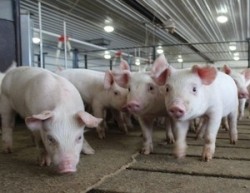New guide offers data, research for canola meal use

The guide, last updated in 2009, has included results of new research looking at how the meal can best be used by producers, or how use affects different species, said Carson Callum, canola meal manager with the council. It also includes a look at the nutritional profile taken from samples at multiple processing plants.
“This guide is targeted to nutritionists in the livestock industry,” he told FeedNavigator. “Whether it be at a feed mill or private operation, we hope this guide will be a go to for feed ration formulas involving canola meal. Most of the values in common use are based on older varieties of meal, and the guide will provide the feed industry with accurate, up-to-date information.”
About 20m acres of canola are planted annually in Canada, council officials said in the guide. And, about 15m tons of seed are processed every year.
Exports of canola meal have increased from about 2.9b tons in 2010-11 to 3.4b tons in 2013-14, they said.
The council’s goal is to boost production to about 52 bushels an acre or 26m tons by 2025 predominately through improving crop growth and higher yielding plants, Callum added.
Canola research developments
The goal of the updates is to offer more recent research and provide better data to feed nutritionists, said Callum.
“A key example in dairy production would be the rumen undegradable protein value,” he said. “Older information in the NRC [National Research Council] has undervalued canola meals protein content that escapes the rumen and is utilized by the cow for milk production.”
Work with the feed ingredient values offers a better look at how to use canola as part of a mixed ration for dairy cows, he said. And, the data includes how it can be used in programs like ration formulation software.
“In the swine section, it shows that due to plant breeding, the anti-nutritional factor, glucosinolates, have greatly decreased, in modern canola meal leading to inclusions rate up to 20% of the diet without an effect on production,” he said. “Methods have also changed. The net energy system and ileal amino acid digestibility for swine allowed us to more accurately feed canola meal, and showed dollar savings.”
New research using the meal also has established a more accurate picture of information on amino acid values for poultry, he said. The ways that protein and energy values are assessed has also changed since 2009.
The guide also has more information regarding use of canola in aquaculture, and collects data from several studies in that area, council officials said. One study found that the meal could comprise up to 30% of the diet for tilapia, and others had a similar usage finding in catfish and rainbow trout.
Although some of the research cited in the updated document was funded through the Canola Council’s Science Cluster, several were independent projects, Callum said.
What’s next
However, there are some areas regarding the feeding of canola that the Canola Council is still working to address including the available energy content and fiber in the meal, said Callum.
“We are also looking beyond lysine and methionine to determine the next most limiting amino acid for ruminants,” he said. “Such research will allow more accurate formulation.”







